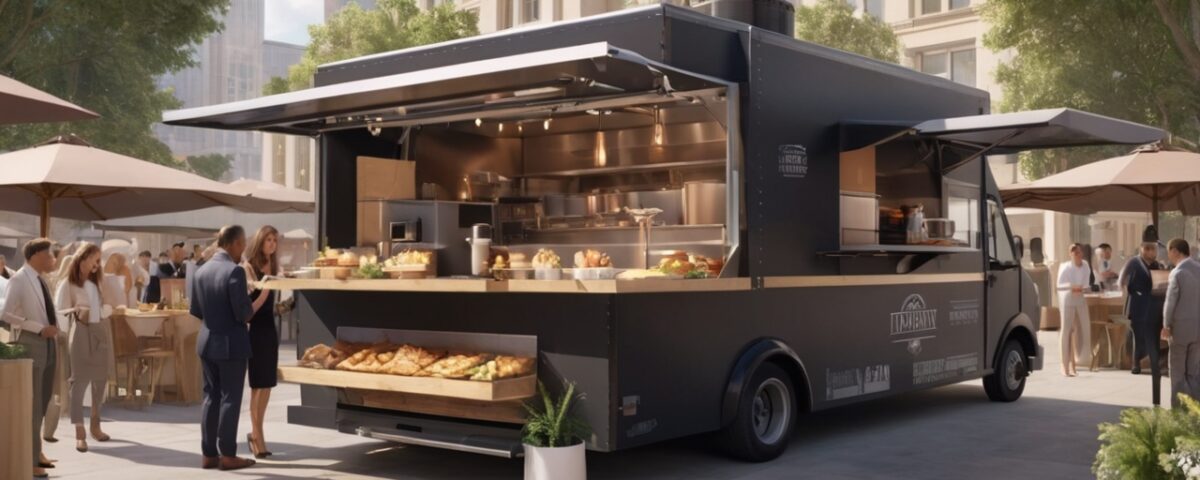
From Street Food to Fine Dining: The Evolution of Food Truck Culture2025
October 25, 2025
How to Rent the Perfect Food Truck for Your Next Event2025
October 25, 2025Mobile Catering Made Easy: A Step-by-Step Guide for Event Planners
Imagine a bustling event where the aroma of sizzling food floats in the air, guests are captivated by the culinary spectacle, and every dish arrives fresh and perfectly prepared. Mobile BBQ Catering isn’t just a trend—it’s a transformative approach to modern event planning. But how can you, as an event planner, navigate this dynamic world and ensure every detail runs flawlessly? This step-by-step guide walks you through the process, from selecting the perfect vendor to creating an unforgettable guest experience.
Why Mobile Catering is Revolutionizing Events
Traditional catering relies on fixed kitchens, plated courses, and often rigid logistics. Mobile BBQ Catering, however, brings the kitchen to your guests, providing flexibility, freshness, and a touch of showmanship. Food trucks, pop-up kitchens, and mobile bars allow planners to host events in previously inaccessible locations—from rooftops to remote beaches—without sacrificing quality or presentation.
Guests now crave interactive experiences. Watching a chef craft artisanal tacos, slice a wood-fired pizza, or assemble gourmet sliders elevates dining into theater. Event planners who leverage Mobile BBQ Catering can merge culinary delight with immersive engagement, creating moments that linger long after the last bite.
Step 1: Define Your Event Needs
Start by outlining the event’s objectives. Is it a corporate gathering, wedding, private party, or festival? Define the expected guest count, preferred service style, and dietary requirements. This clarity ensures your catering choice aligns seamlessly with your vision.
Consider location logistics. Is the site accessible for trucks or mobile kitchens? Will additional power, water, or permits be necessary? Addressing these factors early prevents last-minute complications and ensures a smooth setup.
Think about timing and guest flow. Will guests be served simultaneously or in waves? Understanding these dynamics influences vendor choice, staff allocation, and menu design.
Step 2: Research and Vet Mobile Caterers
Not every mobile catering vendor delivers consistent quality. Prioritize vendors with robust experience, valid health certifications, liability insurance, and positive references. Ask about prior events similar to yours and request a sample menu or tasting session if possible.
Evaluate the vendor’s specialties—some excel at BBQ and smoked meats, others in gourmet desserts or international cuisines. Match their strengths with your event theme and audience preferences. Don’t overlook staffing, setup support, and cleanup services—these elements are crucial for seamless execution.
Interview vendors thoroughly: How many staff accompany the truck? What is your typical service pace? How do you handle dietary restrictions? A comprehensive understanding avoids surprises and sets expectations clearly.
Step 3: Curate the Perfect Menu
Menu selection is pivotal. Dishes must be mobile-friendly, maintain quality during transport, and ideally allow for on-site finishing to ensure freshness. Options like gourmet sliders, artisanal flatbreads, or interactive food stations can engage guests and provide flexibility for different dietary needs.
Incorporate a balance of crowd-pleasers and signature items that reflect your event’s theme. Interactive stations, such as build-your-own tacos or dessert assemblies, encourage engagement. Discuss portion sizes, serving style, and presentation methods with your vendor to maintain both elegance and efficiency.
Consider seasonal ingredients and local sourcing. They not only enhance flavor but align with sustainability trends that guests increasingly appreciate.
Step 4: Logistics and Site Planning
Conduct a thorough site assessment. Evaluate truck access, ground stability, power and water availability, and waste disposal options. Allocate space for guest circulation, seating, and service flow. Safety protocols—including fire safety equipment and first-aid accessibility—are non-negotiable.
Establish a precise schedule: truck arrival, setup, cooking, service start, and cleanup. Factor in buffers for unexpected delays such as weather, traffic, or equipment malfunctions. Clear communication with your vendor ensures timelines are realistic and achievable.
Guest comfort is paramount. Provide shaded areas, seating, and accessible amenities. Thoughtful planning enhances the overall experience and encourages lingering enjoyment.
Step 5: Staffing and Event Flow
Even with a single mobile unit, coordination is essential. Chefs, line staff, servers, and cleanup crew must work in harmony. Designate a point person to manage guest flow, troubleshoot issues, and communicate with the vendor.
Consider the guest journey. How will they approach the truck, place orders, and receive their meals? Clear signage, organized lines, and engaging interactions streamline the process while maintaining an elevated experience. Staff should be trained to provide recommendations, handle dietary inquiries, and add a personable touch to the event.
Real-World Example: Waterfront Wedding Reception
At a waterfront wedding for 180 guests, planners integrated three mobile catering units: a seafood station, a BBQ grill, and a dessert truck. Guests enjoyed watching chefs prepare oysters, smoke brisket, and craft delicate pastries in real-time. The mobility allowed the event to occupy multiple scenic zones along the water, enhancing photo opportunities and engagement. Feedback highlighted both the quality of the food and the dynamic, interactive experience.
Step 6: Contracts and Legal Considerations
Ensure contracts detail date, time, guest count, menu items, pricing, cancellation policies, insurance requirements, and cleanup responsibilities. Include contingencies for weather, late arrivals, or technical failures. Explicit agreements protect both the planner and vendor, reducing day-of stress.
Consider clauses for overtime service, additional guests, and public permits if applicable. Specify responsibilities for power access, parking, and waste disposal. Comprehensive contracts align expectations and safeguard all parties.
Step 7: Post-Event Evaluation
After the event, gather feedback from attendees, staff, and the vendor. Document observations on service speed, food quality, guest satisfaction, and logistical efficiency. Highlight successes and areas for improvement to refine future events.
Maintain a record of preferred vendors, menu choices, and setup strategies. This repository streamlines planning, ensures consistency, and strengthens relationships with trusted catering partners.
Conclusion
Mobile catering transforms ordinary events into immersive, memorable experiences. By clearly defining event needs, carefully selecting vendors, designing engaging menus, and managing logistics and staffing, planners can deliver seamless, unforgettable events. Embrace mobile catering to elevate your next gathering, delight your guests, and create moments that linger long after the final course.
FAQ
- Q: How early should I book a mobile catering service for an event?
- A: It’s recommended to book 6–8 weeks in advance for smaller events and 3–4 months for larger gatherings to secure vendor availability and desired menu options.
- Q: Can mobile caterers handle dietary restrictions effectively?
- Yes. Professional mobile caterers provide vegetarian, vegan, gluten-free, and allergen-friendly options. Always communicate specific requirements ahead of time to ensure proper preparation.
- Q: How many guests can a single mobile catering unit serve efficiently?
- Depending on menu complexity and service style, a single unit can serve 50–150 guests. Larger events may require multiple units or supplementary catering support for optimal flow and service.



